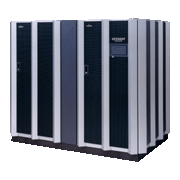The FUJITSU GP7000F 2000, announced in July 1999, was the flagship model of the GP7000F UNIX server family. The 2000 was a versatile machine well suited for Internet server farms and other business applications as well as for large-scale scientific computing projects. Above all, this model represented a significant step forward in scalability over previous models.
Features of the FUJITSU GP7000F 2000 model:
- (1)High performance and scalability
- The 2000 ran on 64-bit RISC-based*1 SPARC*2 64-GP (300 MHz) processors developed by Fujitsu. With its SMP*3 architecture, it could be expanded up to 64 processors. The system bus used crossbar busses built with 0.18-micron CMOS technology and attained a maximum speed of 51.2 GB/s (in a 128-CPU configuration). The system bus also featured high-speed access capability with less than 300 ns latency. Furthermore, the system was scalable up to as many as 1,024 CPUs when arranged in the maximum 16-node cluster configuration (with a maximum of 64 CPUs per node).
- (2)Flexible system construction
- The system environment could be configured flexibly since it permitted mixing CPUs with different clock speeds and allowed one GP7000F 2000 machine to be partitioned into as many as 15 separate operating system environments.
- (3)99.999% availability
- The 2000 boasted a 99.999% availability ratio (less than five minutes of system interruption time per year) — which was on par with large-scale mainframes — because of its enhanced hardware RAS functions, hot-standby cluster systems, and remote maintenance features. The enhanced RAS functions included ECC memory,*4 I/O bus failover, and hot-swapping.*5
- *1. RISC: Reduced instruction set computer.
*2. SPARC: Processor standard developed by SPARC International.
*3. SMP: Symmetric multiprocessor. A multiprocessor architecture where multiple processors, which function identically, are connected to a single shared main memory.
*4. ECC: Error checking and correction. A memory-error handling method capable of correcting one-bit memory errors and detecting two-bit errors.
*5. Hot-swapping: The ability to maintain the machine (such as component replacements) without stopping the computer’s operation. This technology is essential for 24-hour continuous computer operation.
| Introduced | July 1999 |
|---|---|
| Processor | SPARC 64-GP (300 MHz) |
| No. of processors | 8 - 64 |
| Main memory capacity | 4 GB - 64 GB |
| Max. disk capacity | 700 TB |
| OS | Solaris7 |
| Other details |
|
The specifications above were correct at the time the products were announced. Some specifications were later revised due to product upgrades.



